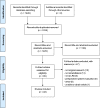Unravelling 'low-resource settings': a systematic scoping review with qualitative content analysis
- PMID: 34083239
- PMCID: PMC8183220
- DOI: 10.1136/bmjgh-2021-005190
Unravelling 'low-resource settings': a systematic scoping review with qualitative content analysis
Abstract
Introduction: The effects of healthcare-related inequalities are most evident in low-resource settings. Such settings are often not explicitly defined, and umbrella terms which are easier to operationalise, such as 'low-to-middle-income countries' or 'developing countries', are often used. Without a deeper understanding of context, such proxies are pregnant with assumptions, insinuate homogeneity that is unsupported and hamper knowledge translation between settings.
Methods: A systematic scoping review was undertaken to start unravelling the term 'low-resource setting'. PubMed, Africa-Wide, Web of Science and Scopus were searched (24 June 2019), dating back ≤5 years, using terms related to 'low-resource setting' and 'rehabilitation'. Rehabilitation was chosen as a methodological vehicle due to its holistic nature (eg, multidisciplinary, relevance across burden of disease, and throughout continuum of care) and expertise within the research team. Qualitative content analysis through an inductive approach was used.
Results: A total of 410 codes were derived from 48 unique articles within the field of rehabilitation, grouped into 63 content categories, and identified nine major themes relating to the term 'low-resource setting'. Themes that emerged relate to (1) financial pressure, (2) suboptimal healthcare service delivery, (3) underdeveloped infrastructure, (4) paucity of knowledge, (5) research challenges and considerations, (6) restricted social resources, (7) geographical and environmental factors, (8) human resource limitations and (9) the influence of beliefs and practices.
Conclusion: The emerging themes may assist with (1) the groundwork needed to unravel 'low-resource settings' in health-related research, (2) moving away from assumptive umbrella terms like 'low-to-middle-income countries' or 'low/middle-income countries' and (3) promoting effective knowledge transfer between settings.
Keywords: health systems; public health; qualitative study; review.
© Author(s) (or their employer(s)) 2021. Re-use permitted under CC BY-NC. No commercial re-use. See rights and permissions. Published by BMJ.
Conflict of interest statement
Competing interests: None declared.
Figures
Similar articles
-
Beyond the black stump: rapid reviews of health research issues affecting regional, rural and remote Australia.Med J Aust. 2020 Dec;213 Suppl 11:S3-S32.e1. doi: 10.5694/mja2.50881. Med J Aust. 2020. PMID: 33314144
-
Eating soup with nails of pig: thematic synthesis of the qualitative literature on cultural practices and beliefs influencing perinatal nutrition in low and middle income countries.BMC Pregnancy Childbirth. 2016 Jul 28;16(1):192. doi: 10.1186/s12884-016-0991-z. BMC Pregnancy Childbirth. 2016. PMID: 27464710 Free PMC article. Review.
-
Digital Health Technologies for Maternal and Child Health in Africa and Other Low- and Middle-Income Countries: Cross-disciplinary Scoping Review With Stakeholder Consultation.J Med Internet Res. 2023 Apr 7;25:e42161. doi: 10.2196/42161. J Med Internet Res. 2023. PMID: 37027199 Free PMC article.
-
How natural is the supernatural? Synthesis of the qualitative literature from low and middle income countries on cultural practices and traditional beliefs influencing the perinatal period.Midwifery. 2016 Aug;39:87-97. doi: 10.1016/j.midw.2016.05.005. Epub 2016 May 10. Midwifery. 2016. PMID: 27321725 Review.
-
Organizational Conditions That Impact the Implementation of Effective Team-Based Models for the Treatment of Diabetes for Low Income Patients-A Scoping Review.Front Endocrinol (Lausanne). 2020 Jul 15;11:352. doi: 10.3389/fendo.2020.00352. eCollection 2020. Front Endocrinol (Lausanne). 2020. PMID: 32760344 Free PMC article.
Cited by
-
Rethinking Scale-Up of Rehabilitation for Chronic Disease in Low-Resource Settings: Embracing Complexity for Contextual Impact.Glob Heart. 2024 Oct 7;19(1):76. doi: 10.5334/gh.1360. eCollection 2024. Glob Heart. 2024. PMID: 39398100 Free PMC article.
-
Data on the clinical, functional, and patient-reported outcomes of patient-centred rehabilitation for patients with non-communicable disease living in low-resourced settings.Data Brief. 2022 Oct 8;45:108665. doi: 10.1016/j.dib.2022.108665. eCollection 2022 Dec. Data Brief. 2022. PMID: 36426058 Free PMC article.
-
The engaged community action for preventing suicide (ECAPS) model in Latin America: development of the ¡PEDIR! program.Soc Psychiatry Psychiatr Epidemiol. 2023 Jun;58(6):861-870. doi: 10.1007/s00127-022-02400-0. Epub 2023 Jan 25. Soc Psychiatry Psychiatr Epidemiol. 2023. PMID: 36695917 Free PMC article.
-
Are we levelling the playing field? A qualitative case study of the awareness, uptake and relevance of the IOC consensus statements in two countries.Br J Sports Med. 2023 Nov;57(21):1371-1381. doi: 10.1136/bjsports-2022-105984. Epub 2023 Feb 1. Br J Sports Med. 2023. PMID: 36725283 Free PMC article.
-
Measuring treatment burden in people with Type 2 Diabetes Mellitus (T2DM): a mixed-methods systematic review.BMC Prim Care. 2024 Jun 10;25(1):206. doi: 10.1186/s12875-024-02461-x. BMC Prim Care. 2024. PMID: 38858619 Free PMC article.
References
-
- World Health Organisation . WHO | social determinants of health. WHO, 2020. Available: http://www.who.int/social_determinants/en/ [Accessed 31 Aug 2020].
Publication types
MeSH terms
LinkOut - more resources
Full Text Sources
Medical



